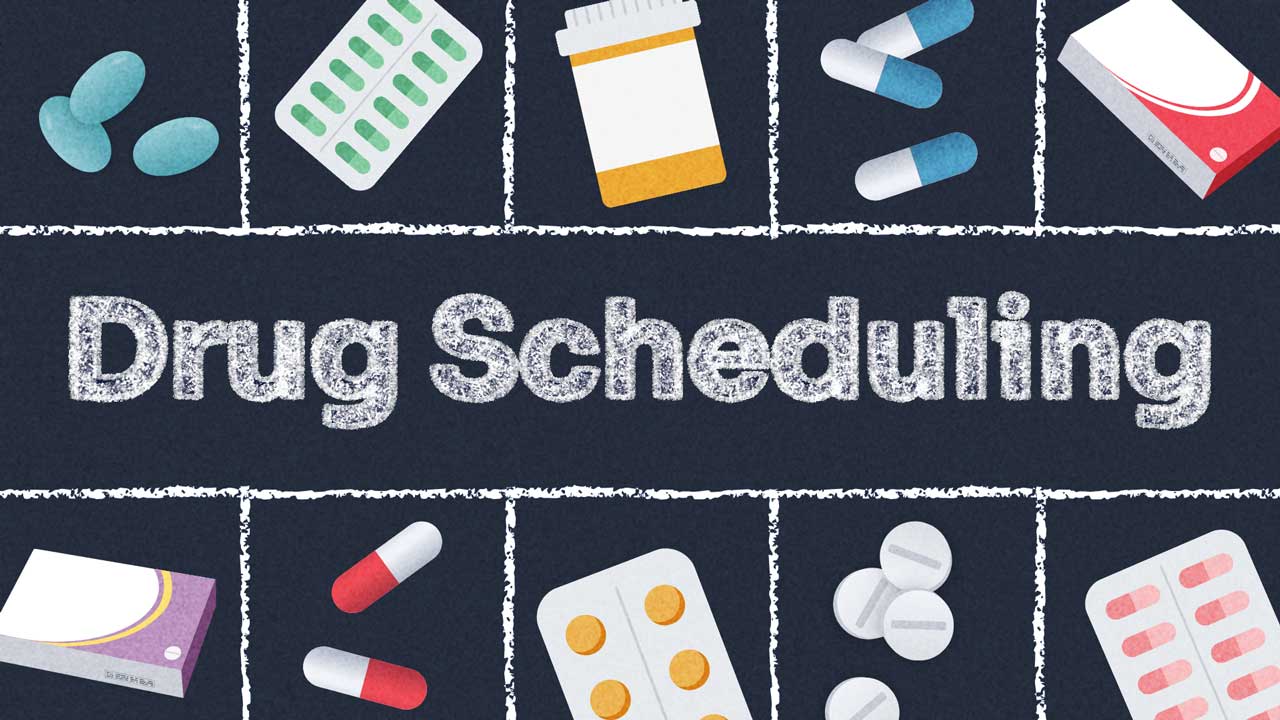All medicines in Australia are categorised by how they are made accessible to the public. This system is called ‘Scheduling’ and is intended to protect the health and safety of the public.
As you would expect, medicines with a lower safety risk are generally less rigidly controlled than medicines that have a higher safety risk.
Some medicines have an inherently higher chance of causing harm than others, while certain medicines are more likely to be misused because they have high rates of dependency or addiction (Healthdirect 2022).

Scheduled Medicines in Order
There are 10 categories (known as ‘Schedules’) of medicine, classified in descending order of legislative controls.
Each category has its own rules for how the medicine or poison should be labelled, sold, bought, stored and disposed of. These categories also inform whether a prescription is needed to buy that particular medicine (Healthdirect 2022).
Note: Most medicines are in Schedules 2, 3, 4 or 8. Schedules 5, 6 and 7 mostly comprise chemicals used for domestic, agricultural and industrial purposes (TGA 2020).
Schedule 1
Not currently in use.
Schedule 2
Pharmacy medicine: Medicines that are available in pharmacies on the shelf.
Examples: Analgesics and local anaesthetics that are bought over-the-counter.
Schedule 3
Pharmacist only medicine: Medicines that are available from a pharmacist but do not require a prescription. These medicines are often behind the pharmacy counter.
Examples: Analgesics and local anaesthetics that are bought over-the-counter.
Schedule 4
Prescription-only medicine: Medicines that have to be prescribed by an authorised healthcare professional. They may be supplied in hospitals or purchased from a pharmacy with a prescription.
Examples: Local anaesthetics, antibiotics and strong analgesics.
Schedule 5
Caution: Chemicals that are unlikely to cause harm. They require appropriate packaging with simple, clear warnings and safety directions on the label.
Schedule 6
Poison: Chemicals with a moderate risk of harm. They require appropriate packaging with a strong warning and safety directions on the label.
Schedule 7
Dangerous poison: Chemicals that have a high risk of causing harm in low doses. They are only available to people who are capable of handling them safely. There are particular rules for selling, using or storing these chemicals.
Schedule 8
Read: Managing Schedule 8 Medicines Safely
Controlled drug: Medicines that have strict rules for producing, supplying, distributing, owning and using them. These may only be prescribed by an authorised healthcare professional, who may require a special prescribing permit.
Examples: Opioid analgesics, ketamine, certain benzodiazepines (flunitrazepam and alprazolam).
Schedule 9
Prohibited substances: Chemicals that may be abused or misused. They are only legal to produce, own, sell or use for medical or scientific research.
Schedule 10
Chemicals that are so dangerous they are banned.
(Healthdirect 2022; Vic DoH 2021)
Note that some medicines, such as vitamins and herbal remedies, are categorised as 'unscheduled'. It is not considered necessary to limit access to these medicines, but this does not mean that they are considered harmless (Healthdirect 2022).

Is the Scheduling System Australia-Wide or State and Territory Based?
Although the Scheduling system is nationally based, legislation relating to the storage and supply of medicines is managed by the states and territories.
While they are mostly very similar, there are some differences depending on the medicine Schedule (The Pharmacy Guild of Australia 2016).
The Poisons Standard
The Poisons Standard outlines the reasoning behind classifying medicines and poisons into Schedules and how this relates to relevant legislation of the states and territories (TGA 2024).
The Poisons Standard also includes model provisions for containers and labels, a list of products to be exempt from these provisions, and recommendations for other controls on drugs and poisons (TGA 2024).
It is intended to promote uniform Scheduling of substances and uniform labelling and packaging requirements in Australia (TGA 2024).

More information about Scheduling can be found on the Therapeutic Goods Administration (TGA) website. The TGA is part of the Department of Health, responsible for regulating health products.
Test Your Knowledge
Question 1 of 3
True or false: Medicines that are available from a pharmacist but do not require a prescription are Schedule 5 medicines.
Topics
Further your knowledge
References
- Department of Health 2021, Scheduled Medicines, Victoria State Government, viewed 4 February 2025, https://www.health.vic.gov.au/drugs-and-poisons/scheduled-medicines
- Healthdirect 2022, Scheduling of Medicines and Poisons, Australian Government, viewed 4 February 2025, https://www.healthdirect.gov.au/scheduling-of-medicines-and-poisons
- The Pharmacy Guild of Australia 2016, Frequently Asked Questions About Medicine Scheduling, The Pharmacy Guild of Australia, viewed 4 February 2025, https://www.guild.org.au/__data/assets/pdf_file/0024/5973/frequently-asked-questions-about-medicine-scheduling.pdf
- Therapeutic Goods Administration 2020, Introduction to the Poisons Standard, Australian Government, viewed 4 February 2025, https://www.tga.gov.au/sites/default/files/introduction-poisons-standard.pdf
- Therapeutic Goods Administration 2024, The Poisons Standard (the SUSMP), Australian Government, viewed 4 February 2025, https://www.tga.gov.au/how-we-regulate/ingredients-and-scheduling-medicines-and-chemicals/poisons-standard-and-scheduling-medicines-and-chemicals/poisons-standard-susmp-0
 New
New 

